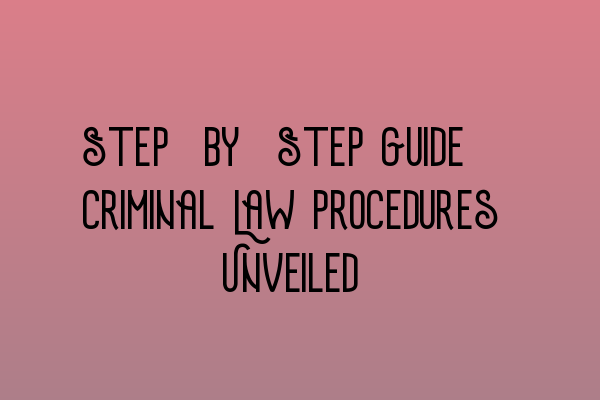Step-by-Step Guide: Criminal Law Procedures Unveiled
Welcome to the SQE Criminal Law & Practice Law UK blog! In this comprehensive guide, we will walk you through the step-by-step procedures of criminal law cases. Whether you’re a law student, legal professional, or simply interested in understanding the criminal justice system, this article is for you.
1. Investigation Stage
The criminal law procedures begin with the investigation stage. This is where law enforcement agencies such as the police gather evidence, interview witnesses, and collect information to build a case. It is crucial for investigators to follow proper protocols and respect individuals’ rights during this process.
If you want to test your knowledge of criminal law procedures, check out our SQE 1 Practice Exam Questions to assess your understanding.
2. Arrest and Charging
If the investigation leads to sufficient evidence, the next step is the arrest and charging of the suspect. This involves taking the suspect into custody and formally charging them with a specific crime. At this stage, it is crucial for the arresting officers to inform the suspect of their rights, including the right to legal representation.
For SQE 1 preparation courses to excel in criminal law, check out our SQE 1 Preparation Courses.
3. Bail Hearing
After the arrest, the suspect may have the opportunity to apply for bail. A bail hearing is conducted to determine whether the suspect should be released under certain conditions while awaiting trial. Factors such as the seriousness of the crime, flight risk, and public safety are taken into consideration during the bail hearing.
4. Plea Bargaining
Plea bargaining is the negotiation process between the prosecution and the defense in order to reach a mutually acceptable agreement. This often involves the defendant pleading guilty to a lesser offense in exchange for a reduced sentence. Plea bargaining can help expedite the legal process and reduce the burden on the court system.
Apply your knowledge with our SQE 1 Practice Mocks FLK1 FLK2 to simulate real courtroom scenarios.
5. Trial
If the case proceeds to trial, it will be presented before a judge and/or jury. The prosecution presents evidence and arguments to prove the defendant’s guilt, while the defense presents counterarguments and challenges the prosecution’s case. The trial concludes with a verdict, where the judge or jury determines the defendant’s guilt or innocence.
For SQE 2 preparation courses to enhance your understanding of criminal law procedures, check out our SQE 2 Preparation Courses.
6. Sentencing
If the defendant is found guilty, the next step is the sentencing hearing. The judge considers various factors, such as the severity of the crime, the defendant’s criminal history, and any mitigating or aggravating circumstances. The judge then determines an appropriate sentence, which can range from fines and probation to imprisonment.
7. Appeals
If either the prosecution or the defense is dissatisfied with the trial’s outcome, they have the right to appeal the decision. The appeal process involves presenting arguments to a higher court, asking them to review the case for errors or unfairness that may have affected the outcome. Appeals can result in the case being retried or the original decision being upheld.
To stay updated with SRA SQE exam dates, visit our page on SRA SQE Exam Dates.
That concludes our step-by-step guide to criminal law procedures. We hope this article has provided you with a clear understanding of the various stages involved in criminal cases. If you have any further questions or are interested in pursuing a legal career, don’t hesitate to reach out to SQE Criminal Law & Practice Law UK.
